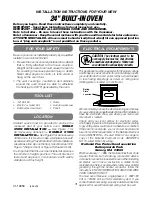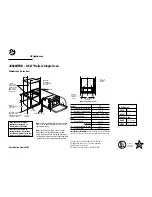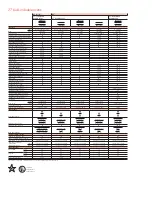
PRECAUTIONS TO AVOID POSSIBLE EXPOSURE TO
EXCESSIVE MICROWAVE ENERGY
1) Do not attempt to operate this oven with the door open since this can result in harmful exposure to microwave energy.
It is important not to damage or tamper with the safety locks.
2) Do not place any object between the oven front face and the door, or allow soil or cleaning residue to accumulate on
sealing surfaces.
3)
Do not operate the oven if it is damaged.
It is particularly important that the door closes properly and there is no
damage to the:
(A) door
(bent,)
(B) hinges and latches
(broken or loose,)
(C)door seals and sealing surface.
4) The oven should not be adjusted or repaired by anyone except qualifi ed service personnel.
PERMISSIBLE MATERIALS
CAUTION: PERSONAL INJURY HAZARD
Tightly-closed containers could explode. Closed containers
should be opened and plastic pouches should be pierced
before cooking.
This section lists which utensils can be used in the microwave, which ones have limited use for short periods, and which
ones should not be used in the microwave
.
RECOMMENDED
Microwave browning dish
— Use to brown the exterior of small items such as steaks, chops, or pancakes. Follow the
directions provided with your browning dish.
Microwaveable plastic wrap
— Use to retain steam. Leave a small opening for some steam to escape and avoid placing
it directly on the food.
Paper towels and napkins
— Use for short-term heating and covering; these absorb excess moisture and prevent spat-
tering. Do not use recycled paper towels, which may contain metal and could ignite.
Glass and glass-ceramic bowls and dishes
— Use for heating or cooking.
Paper plates and cups
— Use for short-term heating at low temperatures. Do not use recycled paper, which may contain
metal and could ignite.
Wax paper
— Use as a cover to prevent spattering.
Thermometers
— Use only those labeled “Microwave Safe” and follow all directions. Check the food in several places.
Conventional thermometers may be used on microwave food once the food has been removed from the oven.
LIMITED USE
Aluminum foil
— Use narrow strips of foil to prevent overcooking of exposed areas. Using too much foil can damage
your oven, so be careful. You should keep distance of 1 inch (2.54cm) between aluminum foil and cavity.
Ceramic, porcelain, and stoneware
— Use these if they are labeled “Microwave Safe”. If they are not labeled, test them
to make sure they can be used safely.
Plastic
— Use only if labeled “Microwave Safe”. Other plastics can melt.
5






































